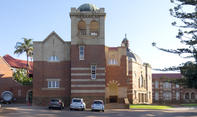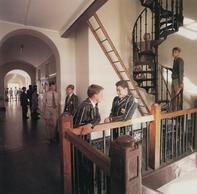Placement of the School
The obvious approach to the siting of the new Pretoria High School in the 1800s would have been to place the building on the level terrain at the foot of the hill. Architect Mr. Tyrwhitt’s solution was that of placing the building on a fairly narrow terrace well up the hillside, which turned out to be a much happier and more imaginative one, giving the school a dramatic setting.

Early photographs of the school show that it was built on a steep, rocky and treeless hillside. The laying out of the grounds, now in modern times so well-wooded and verdant, was a major undertaking which went on for more than a quarter of a century. Much of the work - the terracing, the building of masonry retaining walls, and the planting, in the hard pink shale, of hundreds of trees - was carried out by a team of pensioners.
At the beginning of 1909 General Smuts, then colonial secretary of the Transvaal and one of the behind-the-scenes initiators of the new school, officially opened the doors of the new school building. A few days later the 180 boys and staff of the Pretoria College moved into their new home. A year later, in 1910 - shortly before the formation of the Union of South Africa - a further 100 boys and staff, those of the Eendracht Hoärskool, moved in to join the incumbents and the school was officially renamed Pretoria High School for Boys/Pretoria Hogereskool Voor Jongens.
Jan Smuts
That Jan Smuts had been involved on such a personal level with the second founding of the high school in Tshwane might strike the casual observer as strange; and that the pupils of an additional school - and a Dutch one at that - had been amalgamated with the English school certainly needs explanation.
For the answer one need only examine the timing: the second founding of Pretoria High School coincided with the declaration of the Union of South Africa in 1910. The establishment of a dual-medium school in Tshwane, the capital of the Union, was the start of a brave experiment in the history of education in South Africa: a school where English and Afrikaans-speaking boys would mix and mingle - and would, it was hoped, be a catalyst to bring unity at grass-roots level to the two 'white tribes' of the country, helping to heal the scars of the South African War.
Putting his money where his mouth was, Smuts enrolled his two sons at the school; and their contemporaries were General Louis Botha's two sons and Albert Hertzog, son of General JB Hertzog, at different times ally and opponent of Smuts.
Headmaster William Hendrik Hofmeyr

Such a school - a symbol and demonstration of much hoped-for unity needed a particular type of headmaster, and Smuts's hand-picked candidate that had all the qualifications necessary to make the aspirations of the school's supporters become a reality.
William Hendrik Hofmeyr (Cantab and the University of the Cape of Good Hope), a product of the famous Cape family of 'Onze Jan' stayed for a quarter of a century and became the school's most famous and longest-sening headmaster, and a legend in his time.
William Hendrik Hofmeyr firmly established the school and under him it's ethos crystallised. All seven of Hofmeyr's sons were pupils at Pretoria Boys' High School, and all were fine sportsmen and scholars.
Matter of Pride
A year after headmaster William retired, his son Will joined the staff of Pretoria Boys' High School as a teacher and stayed there until his retirement in 1977. Like his brothers, Will was an outstanding scholar - he was a Latin expert and was by all accounts a magnificent teacher of the subject - and a fine sportsman, becoming one of the legendary coaches of rugby and cricket at the school.
Under him the rugby team beat their traditional rivals Afrikaans Hoärseunskool seven years in a row, an unparalleled achievement. Today, the sports facilities of Pretoria Boys' High School are a matter of pride, and the Will Hofmeyr cricket oval takes first place as one of the finest of all schools in the country.